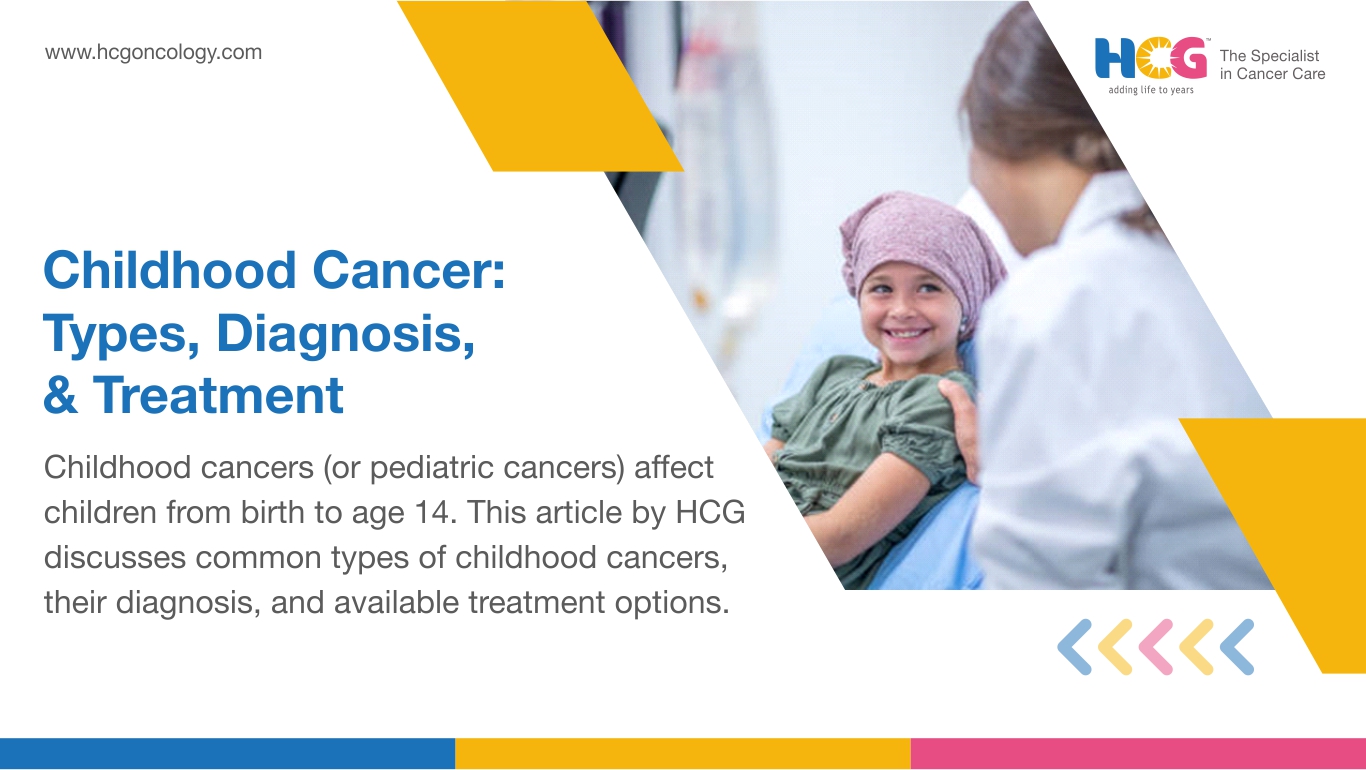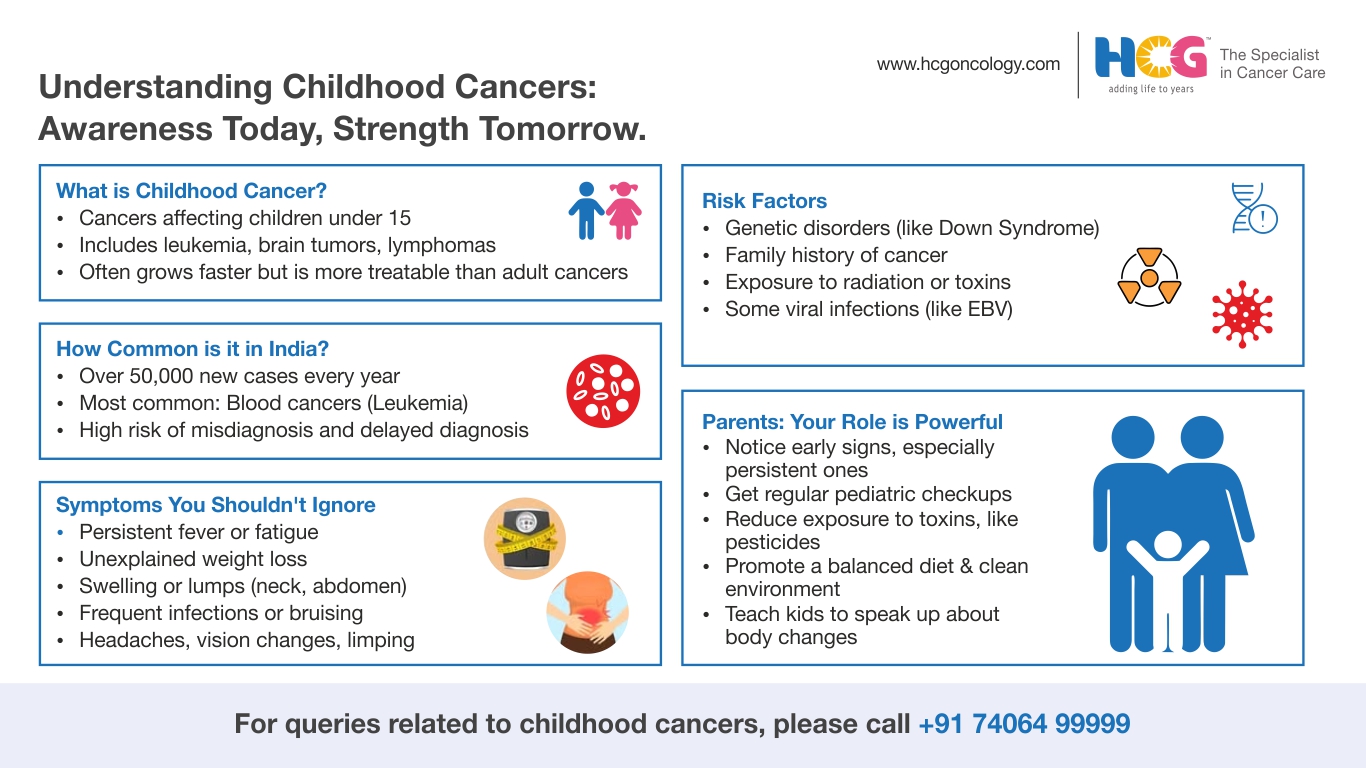
07 Nov, 2025
Feel free to reach out to us.

07 Nov, 2025
%20DM%20(%20Medical%20Oncology)%20(1)%20(1).jpg)
This article is medically reviewed by Dr. Boppana Sai Madhuri, Consultant - Medical Oncology, HCG Cancer Centre, Vijayawada.

Childhood cancer, or pediatric cancer, refers to the group of cancers diagnosed in children and adolescents aged 0 to 19 years.
Although these cancers are relatively rare compared to adult cancers, they are one of the leading causes of death in this patient population.
Around 4 lakh children and adolescents are diagnosed with cancer globally. India records about 50,000 pediatric cancer cases every year. Some of the common types of pediatric cancer are leukemia, lymphoma, brain and spinal cord tumors, neuroblastoma, and Wilms' tumor.
These cancers are usually treatable, especially when diagnosed at an early stage. High-income countries with advanced medical facilities have a 5-year survival rate of 80%. However, the survival rate significantly drops in several low- and middle-income countries because of delayed diagnosis and limited medical facilities.
Global efforts, such as the WHO's Global Initiative for Childhood Cancer, aim to increase the worldwide survival rate to ≥60% by 2030 by improving diagnosis, treatment, and access to medications.
At HCG, we have a dedicated department for pediatric oncology, which comprises experts with specialized expertise in diagnosing, treating, and managing childhood cancers.
Commonly diagnosed childhood cancer types include:
Leukemia is the most common childhood cancer and shares about one-third of all pediatric cancers.
It develops in the bone marrow and affects red and white blood cells and platelets. The two main types include acute lymphoblastic leukemia (most common) and acute myeloid leukemia. Chronic leukemia is rare in children.
Brain and spinal cord tumors are the second most common pediatric cancers and account for about 26% of all pediatric cancer cases.
It involves abnormal cell growth in the central nervous system and may affect vital brain functions. Some common types of brain tumors among children include medulloblastoma, glioma, and ependymoma.
Lymphoma is the third most common cancer in children and starts in the lymphatic system. Its two main types are Hodgkin lymphoma (less common) and Non-Hodgkin lymphoma (more common in children).
Neuroblastoma is a rare cancer and generally affects children <5 years of age.
It typically begins in immature nerve cells. It is the most common cancer in infants and is even detected before birth.
Wilms' tumor is also known as nephroblastoma. It is the most common kidney cancer in children and is usually detected before age 5. It generally affects one kidney and is usually more common in girls.
The early sign of Wilms’ tumor is swelling or a lump in the abdomen.
Retinoblastoma is a rare type of ocular cancer that mostly affects children < 5 years of age. It starts in the retina and may affect one or both eyes.
It accounts for almost 2% of all pediatric cancer cases.
It is the most common soft tissue cancer in children. It generally affects children < 10 years of age.
The muscles of the head, arms, neck, and legs are where it starts. Its types include embryonal and alveolar rhabdomyosarcoma. Although treatment may lead to remission, it has the potential for recurrence. It is slightly more common in boys than in girls.
It is the most common bone cancer in children and adolescents. It is more common in older children and adolescents and is rarely seen in children < 5 years of age.
It generally affects the bones of the arms, legs, or hips. Treatment is effective if cancer is diagnosed early, and it has a 70% survival rate.
It is the second most common bone cancer in children. Boys are more commonly affected. It often occurs in the arms, legs, or pelvis.
Commonly recommended evaluations and tests for diagnosing childhood cancers include:
1. Recognizing Early Symptoms: It is important to recognize early symptoms. The early warning signs are bone pain, unexplained fever, fatigue, weight loss, and the presence of lumps. If these symptoms last for more than 2 weeks, it is essential to see a doctor.
2. Physical Examination and Medical History: Patients undergo a comprehensive physical examination. The doctor may also discuss the medical and family history of patients to determine the cause of the symptoms.
3. Blood and Fluid Tests: Doctors may recommend blood tests to detect abnormal blood cells that may indicate the presence of cancer in children. The other tests include tumor markers in the urine, blood, and cerebrospinal fluid.
4. Imaging Tests: Imaging tests used for diagnosing pediatric cancers are X-rays, ultrasound, computed tomography scans, magnetic resonance imaging, and positron emission tomography. Bone scans may detect bone tumors.
5. Biopsy and Tissue Sampling: A biopsy involves obtaining fluid or tissue samples to detect cancer cells under a microscope. It is usually a confirmatory diagnosis.
6. Bone Marrow and Lumbar Puncture: The doctors collect the samples from the spinal fluid or bone marrow if lymphoma or leukemia is suspected.
Childhood cancers are best managed with personalized treatment plans. The following are the different treatment approaches used to manage childhood tumors:
Chemotherapy involves the use of one or more drugs orally or through injection to kill cancer cells. It is usually administered in cycles that allow for recovery time.
It is an effective and essential treatment for many childhood cancers, especially when used in combination with other therapies.
Radiation therapy utilizes high-energy rays to target and destroy cancer cells. It may be administered alone or in combination with other therapies.
Most children receive external beam radiation therapy. Proton beam therapy has fewer side effects compared to other therapies. Radiation therapy is typically brief, and potential side effects may include skin changes or fatigue.
Stem cell transplant is a technique that replaces abnormal stem cells with healthy ones.
The types of stem cell transplants are autologous (primarily used for treating solid tumors) and allogeneic transplants (mostly used for treating leukemia). Allogeneic transplant has a higher risk of graft-versus-host disease.
Surgery plays an important role in diagnosing and treating many childhood cancers, particularly solid tumors.
Surgeons may then remove as much of the tumor as possible, followed by shrinking it with chemotherapy or radiation therapy. Advanced techniques like cryosurgery, radiofrequency ablation, cytoreductive surgery, and hyperthermic intraperitoneal chemotherapy are less invasive.
Immunotherapy helps the immune system to recognize, attack, and destroy cancer cells more effectively. It is an option for children with leukemia, lymphoma, and neuroblastoma.
Immunotherapy approaches for pediatric cancers include monoclonal antibodies, immune checkpoint inhibitors, and CAR T-cell therapy. Immunotherapy often causes fewer long-term effects than chemotherapy in managing childhood malignancy.
This therapy involves the administration of drugs that interfere with the functioning of specific genes or proteins, or cellular pathways that contribute to cancer growth.
Targeted therapy kills only the malignant cells, leaving healthy tissues intact, resulting in fewer side effects. It is generally used to treat leukemia, lymphoma, and rare solid tumors.
Childhood cancer is rare and is the leading cause of death in children and adolescents. Lymphoma, leukemia, Wilms’ tumor, brain and central nervous system tumors, rhabdomyosarcoma, neuroblastoma, retinoblastoma, and bone cancers are common pediatric cancers. Diagnostic techniques include physical examination, blood tests, imaging tests, and biopsy. Childhood cancer treatment options are chemotherapy, radiation therapy, surgery, immunotherapy, and targeted therapy.
If you are looking for the best cancer hospital in India with a dedicated pediatric hematology or pediatric oncology department, visit your nearest HCG Cancer Centre today.
%20DM%20(%20Medical%20Oncology)%20(1)%20(1).jpg)
Dr. Sai Madhuri Boppana
Consultant - Medical Oncology
MBBS, MD (General Medicine), DM (Medical Oncology), ESMO Certification
Dr. Sai Madhuri Boppana is a skilled medical oncology consultant with more than a decade of experience in administering medical oncology treatments for different types of cancer. She is available for consultations at HCG Cancer Centre, a leading cancer hospital in Vijayawada. Her academic credentials include MBBS, MD (General Medicine), and DM (Medical Oncology) degrees from some of the renowned medical institutes in the country. She has also completed her ESMO certification. Dr. Sai Madhuri believes in individualizing cancer treatment strategies to meet the specific health needs of her patients, as this is crucial for positive health outcomes.
Appointment Link: Book an Appointment with Dr. Sai Madhuri Boppanna.